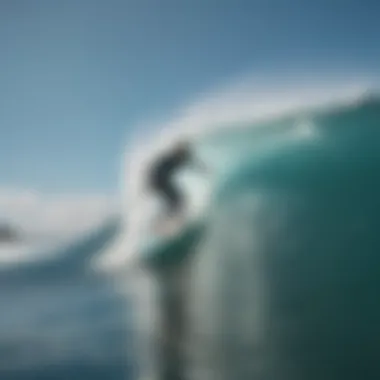Aqua Foil Innovations in Surfing Performance


Intro
Aqua foils, a recent addition to the surfing world, have captured the attention of both novices and seasoned pros alike. This innovation takes surfing to a new level, allowing riders to skim across the water with minimal drag, almost flying above the swell. With its unique design and engineering, aqua foil technology introduces a blend of performance and sustainability that can’t be overlooked. Understanding this technology, its applications, and its varying designs is essential not just for enhancing your riding technique, but also for appreciating the ecological considerations tied into this thrilling sport.
Diving into this article, we will explore the various surfboarding techniques that can be enhanced by aqua foiling and review the latest equipment hit the market. Whether you’re planning to take your first ride or you’re looking to refine advanced maneuvers, knowing how aqua foils change the game is crucial for any water sport fanatic.
"Surfing with an aqua foil feels like dancing on water – every movement becomes an expression of freedom." – A seasoned surfer's take on the innovation.
Soon, we’ll examine the ins and outs of surfboarding techniques, followed by a comprehensive look at available surfboard equipment that includes essential gear for serious and casual surfers alike. Stay tuned for insights that promise not just to elevate your skills, but also deepen your environmental consciousness as a surfer.
Understanding Aqua Foil
Aqua foil technology represents a significant shift in the surfing landscape. It transcends traditional wave riding, offering novel dynamics that appeal to both new and seasoned surfers alike. This section aims to elucidate the importance of aqua foiling within surfing, touching on its transformative potential, the advancements that have happened, and the experiences it facilitates for riders.
Aqua foiling is not just about adding a new piece of equipment to your gear; it's about understanding the very principles of hydrodynamics and embracing innovation. When surfers engage with aqua foils, they're stepping into a realm where wave riding becomes a blend of science and art, pushing the boundaries of what is possible on water.
Definition and Origins
Aqua foil technology has roots in various water sports. Initially, the concept emerged from the need to enhance speed and increase efficiency in the water. The first instances of hydrofoils were adapted from sailing, where they were used to lift boats above water to reduce drag. As time went on, savvy surfers began to recognize that similar technology could dramatically impact surfing.
Aqua foiling, in essence, involves a fin-like structure—often called a foil—attached beneath the surfboard. This foil interacts with the water, generating lift and allowing the board to rise above the wave, thereby gliding more efficiently. The historical context here is essential; understanding the origins of aqua foil helps capture its evolution and the increasing enthusiasm surrounding it.
The Mechanics of Foiling
At its core, aqua foiling hinges on physics. To grasp this technology, surfers must delve into the relevant mechanics that govern it.
Hydrodynamics Explained
Hydrodynamics examines how water flows around objects. In the case of aqua foiling, this is pivotal for defining how efficiently a surfer can navigate waves. A key characteristic of hydrodynamics relevant to aqua foiling is the concept of lift, which is generated as the foil moves through the water. When a surfer angles their board correctly, the water pressure beneath the foil increases, pushing them upward. This upward force is critically beneficial, enabling surfers to ride on top of the wave instead of being carried by it.Exploring these dynamics helps demystify why some designs succeed while others falter.
However, there are complexities to consider as well. The balance of speed and control is crucial for effective foiling, and understanding these intricacies can elevate someone’s experience.
Foil Lift and Drag Forces
Understanding lift and drag forces is fundamental to mastering aqua foiling. As the foil moves through the sea, lift is the force that elevates the board, allowing surfers to glide above swells. On the other hand, drag is the resistance that opposes this lift. The key aspect here rests on the interaction between these two forces.
In aqua foiling, minimal drag is essential for achieving smooth, high-speed rides. A well-designed foil can optimize lift while minimizing drag, making it a sought-after option for performance-oriented surfers. However, achieving that perfect balance can take time to master—often leaning into the technical aspects of riding.
To sum up, recognizing the mechanics behind aqua foiling—particularly hydrodynamics and lift versus drag—provides surfers insight into what makes this technique so captivating. As surfers grow familiar with these concepts, they not only enhance their performance but also enrich their connection to the ocean.
"Aqua foiling offers a unique experience, pushing the limits of traditional surfing while opening doors to new possibilities on the water."
This understanding forms the foundation for exploring further advancements in aqua foils and their impact on surfing.
Types of Aqua Foils
The design and functionality of aqua foils have made a huge impact in the surfing community, leading to innovative approaches in how surfers ride the waves. Understanding the different types of aqua foils is crucial for anyone looking to elevate their surf experience. Each foil type offers a unique set of characteristics, catering to various skill levels, wave conditions, and personal preferences. This section will delve into the distinct designs and materials that define the aqua foil landscape, along with their benefits and drawbacks.
Different Designs
High Aspect Ratio Foils
High aspect ratio foils are known for their elongated shape, which helps reduce drag while providing substantial lift. This characteristic allows for impressive speed and agility, making them a favored choice among many advanced surfers. By increasing the distance between the front and rear wings, these foils enhance stability during high-speed maneuvers.
One notable feature of high aspect ratio foils is their efficiency in flat water, which means they can glide smoothly even without strong waves. This efficiency is particularly beneficial for racing applications or long-distance cruising, providing a seamless experience on the water. However, it’s worth noting that they can be a bit more challenging to control in choppy conditions or during sharp turns.
Low Aspect Ratio Foils
In contrast, low aspect ratio foils boast a shorter, broader design that can be advantageous for wave riding. These foils are excellent for surf conditions that require quick turns and rapid acceleration. The wider wings provide an immediate lift, allowing surfers to feel the push of the wave sooner.
The main benefit of low aspect ratio foils is their exceptional maneuverability, delivering a greater response when carving through powerful swells. However, this comes with a trade-off; they tend to generate more drag at higher speeds, making them less efficient for long-distance rides. Surfers who appreciate playful, dynamic riding often gravitate towards low aspect ratio designs.
Materials Used in Production
The materials used in manufacturing aqua foils significantly affect their performance, weight, and durability. Two commonly used materials are carbon fiber and aluminum alloys, each possessing distinctive properties that cater to various surf conditions and requirements.


Carbon Fiber
Carbon fiber has emerged as a frontrunner in aqua foil production due to its exceptional strength-to-weight ratio. This material allows for a lightweight construction while maintaining structural integrity, essential for delivering speed and agility on the water. Additionally, carbon fiber foils offer seamless flex, meaning they can adjust effortlessly to varying wave conditions.
One of carbon fiber's defining characteristics is its resistance to fatigue, which prolongs the life of the foil even under considerable stress. Nonetheless, this advanced material is often at a higher price point, which may deter some enthusiasts, especially novices.
Aluminum Alloys
Aluminum alloys present a solid alternative to carbon fiber for those seeking durability at a more accessible price. These foils are robust and can withstand harsher environments, making them suitable for beginners who might not yet have mastered control on the waves. The weight of aluminum foils can be slightly heavier than their carbon counterparts, but they provide excellent stability, especially in windy conditions.
One unique feature of aluminum alloys is their corrosion resistance, allowing for longevity even in salty environments. However, in terms of lightweight performance, they might not deliver the same speed as carbon fiber models, which is worth considering based on one’s surf goals.
Quote:
"Choosing the right aqua foil depends on what you want to achieve. Whether it’s high speed, maneuverability, or durability, there’s a design suited for every surfer."
Advantages of Using Aqua Foil
Aqua foiling has transformed the surfing landscape, making it essential for anyone looking to enhance their experience on the waves. The main perks of using aqua foils lie in their ability to significantly improve performance and efficiency while surfing. Understanding these advantages helps enthusiasts and professionals alike to appreciate how aqua foils can elevate their skills and enjoyment in the sport.
Enhanced Performance
Increased Speed
Speed is the name of the game in surfing, and aqua foils deliver on this front. The design of these foils reduces drag while maximizing lift, allowing surfers to glide effortlessly across the water. This revolutionary aspect of increased speed can turn an average ride into something remarkable. Surfers often find themselves catching waves they wouldn’t typically ride.
The unique hydrodynamics of the aqua foil create a lift-to-drag ratio that is vastly superior to traditional boards. This characteristic makes aqua foils a preferred choice for riders aiming to achieve higher speeds without sacrificing control. However, it's worth noting that the learning curve associated with managing this speed can be steep for newcomers.
Improved Maneuverability
When it comes to executing sharp turns and stylish maneuvers, improved maneuverability is invaluable. Aqua foils allow surfers to change direction with less resistance, enhancing their overall agility on the wave. This foiling experience enables agile shifts and intricate tricks, making it a good option for those wanting to elevate their performance.
The unique feature of maneuverability lies in the way aqua foils can be used to carve through waves. This not only enriches the surfing experience but also brings forth new tricks to master, giving riders a reason to stay inspired. On the flip side, for surfers who are accustomed to traditional boards, adjusting to this sleek design might require a bit of practice.
Efficiency in Waves
Wave Utilization
Aqua foils are not just about speed and turns; they excel at maximizing wave potential. Their ability to utilize smaller and less powerful waves is a game changer for surfers. With the right technique, surfers can turn what's usually a mediocre wave into an exhilarating ride.
The efficiency of aqua foils in wave utilization stems from their lift and design. By allowing surfers to ride lower on the water's surface, they can catch more waves, effectively optimizing each surf session. This quality makes wave utilization from aqua foils a highly valuable feature, especially in crowded surf spots where bigger waves become the only option.
Riding Smaller Waves
Riding smaller waves might sound less thrilling, but with aqua foils, it becomes a surprisingly enjoyable experience. These boards are designed to harness energy from waves that would be underwhelming with standard surfboards. This advantage opens up a new realm for surfers, especially in locations or seasons with limited wave heights.
The unique capability to ride smaller waves enhances not only fun but also extends the surfing season. Surfers can capitalize on any swell, no matter how small, without losing the thrill entirely. However, it’s crucial to have a solid grounding in foiling dynamics to maximize this advantage effectively.
"The rise of aqua foils is a testament to innovation in surfing. Not only does it enhance performance, it also reshapes how we interact with the ocean's waves."
Culmination of Advantages
The advantages of using aqua foils highlight a shift in surfing techniques and opportunities. From speed and maneuverability to efficient wave utilization and the ability to ride lesser waves, they offer multifaceted benefits for both seasoned surfers and novices. By embracing this technology, surfers can explore new dimensions in their surfing journey.
Challenges and Drawbacks
While aqua foiling presents exciting possibilities in the world of surfing, it comes with its own set of challenges and drawbacks. Understanding these limitations is essential for surfers who are considering this innovative technology. This section will delve into the learning curve that comes with mastering aqua foils and the financial implications associated with purchasing and maintaining this equipment.
Learning Curve
Learning to foil is not a walk in the park; it’s more of a mixed bag of emotions. Many surfers find themselves grappling with the unique dynamics that foiling presents. Unlike traditional surfing, where balance and positioning are key, foiling requires a different level of finesse. You need to feel the lift under your board and make micro-adjustments to your stance to keep airborne, which can be a bit unnerving at first.
Early attempts often lead to a series of wipeouts as riders learn to control their speed and balance. It can be rather frustrating for those accustomed to the straightforwardness of catching waves on a regular surfboard. Furthermore, the sheer physicality of managing a foil adds an extra layer of complexity. Riders must develop core strength and stability over time.
Fortunately, there are resources available for those looking to conquer this learning curve. Local surf schools and online tutorials can be beneficial. However, new foilers may find the initial transitions daunting, and patience is essential. After all, every pro surfer once started as a novice.
Cost Considerations


When it comes to aqua foiling, one major stumbling block for potential enthusiasts is the cost involved. The initial investment can feel like you're paying for a luxury item, especially for those already knee-deep in their surfboards and accessories. High-quality foils can range quite a lot in price, often starting from several hundred dollars and reaching into the thousands for more advanced models.
Considerables include:
- Equipment Upgrades: Many surfers might feel tempted to upgrade their boards just to keep up with foil technology, which further bumps up costs.
- Maintenance Expenses: Unlike traditional surfboards, foils can require more specialized care and maintenance. This could mean additional costs for repairs or replacement parts, which can add up over time.
- Lessons and Training: If you’re not a self-starter, taking lessons can be an added expense.
There's an argument to be made about the value of quality, as you often get what you pay for. However, for those beginning their foiling journey, the pricetag can turn potential interest into hesitation. Thus, while there are undeniable advantages to aqua foiling, the financial aspect cannot be overlooked.
"The thrill of foiling can easily be overshadowed by sticker shock if you're not ready for the financial commitment."
Given these factors, potential new foilers need to weigh the benefits against the upfront costs. It’s a balancing act that requires careful consideration.
Techniques for Aqua Foiling
When it comes to aqua foiling, understanding the techniques is a game-changer. These methods not only enhance the overall experience but also maximize the potential of the foil itself. Whether a novice or a seasoned surfer, the ability to master various techniques plays a pivotal role in ensuring safety, performance, and enjoyment. Surfers are not just riding a wave; they are engaging in a dance with the ocean, and having the right moves can make all the difference.
Basic Movements and Controls
The grasp of basic movements and controls is foundational for anyone finessing their aqua foiling skills. Learning to balance on the board while manipulating the foil might feel daunting initially. It’s akin to finding your footing on a bike for the first time.
Here are some critical aspects to consider:
- Body Positioning: Keeping your weight centered is essential. A slight shift can either lift the foil out of the water or plunge it.
- Foot Placement: Your feet should be firmly pressed against the board; this aids in maintaining stability while allowing quick adjustments.
- Pilot Movements: A gentle flex of your knees and core strength act like the rudder, guiding your path seamlessly through the waves.
Together, these movements facilitate a smooth ride, ensuring that surfers can enjoy the rush of foiling without unnecessary interruptions.
Advanced Maneuvers
As surfers become more comfortable, they often venture into advanced maneuvers. These techniques push the boundaries of what one can achieve with aqua foiling, offering thrilling excitement alongside a deeper connection with the ocean's rhythm.
Turning Techniques
Turning techniques are where the magic lies for most surfers looking to refine their craft. Imagine carving through the water like a knife through butter; that’s the essence of a well-executed turn.
Key Characteristics:
- Agility: Successful turns require a surfer to quickly shift their weight and determine the best angle against the wave's momentum.
- Edge Control: By using the foil's unique shape, surfers can slice through the water, creating a thrilling ride.
This method is beneficial as it enhances not only speed but also flow, enabling surfers to transition smoothly from one wave to another. The unique feature of turning techniques lies in their versatility. They equip surfers with the ability to adapt to changing conditions—essential when you're out on unpredictable waters. However, it can also lead to falls if executed poorly, which might deter some from fully embracing this skill.
Jumping and Tricks
Jumping and tricks capture the imagination of many; they represent the pinnacle of aqua foiling's capabilities. Performing a jump requires a different mindset than simply riding a wave.
Key Characteristics:
- Impulse: A surfer must spring off the board at just the right moment to lift the foil clear of the water before gracefully landing.
- Timing: Success is rooted in perfect timing, combining rhythm and coordination to achieve aerial maneuvers.
These tricks are appealing because they not only deliver an adrenaline kick but also allow surfers to showcase their skills among peers, providing a sense of achievement. What sets jumping apart is the exhilarating rush it brings, a tangible moment of joy that sticks with you long after you’re back on land. However, mastering these tricks comes with its drawbacks—time and practice are essential. Jumping can risk falls, and without proper technique, the harsh ocean surface becomes an unwelcome friend.
"The thrill of mastering the waves lifts the spirit; it’s like flying without wings."
In summary, from the basics to advanced maneuvers, techniques for aqua foiling encompass a wide range that brings surfers closer to the waters they ride. With every movement mastered and each trick completed, they not only enhance their skills but deepen their love for the sport.
Eco-Conscious Innovations
The conversation around aqua foiling is increasingly being intertwined with eco-conscious innovations. Today's surfers are not just focused on performance and thrills; they're also becoming aware of the environmental impacts of their chosen activities. This section covers how sustainability is not merely an afterthought but is central to the development of aqua foils. The inclusion of sustainable materials, innovative manufacturing practices, and minimized ecological footprint holds great validity in the surfing community. Surfers and manufacturers are recognizing that the waves we ride today depend on the health of the ocean tomorrow.
Sustainable Materials
Bamboo Foil Options
Bamboo as a material for foils stands out due to its unique properties. First off, bamboo is not only strong but also lightweight. This characteristic contributes significantly to enhancing the performance of surfboards and other foiling designs by offering durability without added weight. The bamboo’s natural flexibility can also aid in smoother rides, making it a favored choice for many surfers.
One unique feature of bamboo foils is their rapid growth cycle. Unlike traditional materials that may take years to replenish, bamboo can mature within three to five years, positioning it as a sustainable alternative. This property means that tapping into bamboo resources does not contribute heavily to deforestation. However, a drawback can arise from the potential higher costs of processing bamboo into high-performance foils. In some cases, manufacturers might not have the technology or resources to ensure bamboo foils meet specific performance standards consistently.
Recyclable Composites


The world of recyclable composites is making waves for different reasons. These materials are generally made through repurposing previously used substances, which helps reduce waste significantly. The strength-to-weight ratio of recyclable composites can be impressive, allowing manufacturers to create foils that are not only lighter, but are also capable of delivering excellent performance on the water. This sort of innovation highlights the industry's shift towards greener alternatives.
A unique feature of recyclable composites is that they can be returned to the production cycle once their lifecycle is over. Rather than ending up in landfills, these materials can potentially be reshaped into new foils or equipment. That said, many surfers and manufacturers are still learning about the limits of these materials when it comes to extreme conditions. While they can offer plenty of benefits, long-term durability and performance comparison are still ongoing discussions within the community.
Environmental Impact
Comparative Analysis with Traditional Surfboards
When looking at the environmental implications of aqua foil materials compared to traditional surfboards, a clear difference emerges. Traditional surfboards are often made from expanded polystyrene foam and fiberglass, which can take hundreds of years to decompose. In contrast, the more sustainable options like bamboo and recyclable composites tend to require a significantly lower input of toxic materials and incorporate processes that aim to protect the ecosystem.
The biggest advantage of using eco-friendly materials is not just about reducing environmental harm; it is also about creating awareness among surfers. By drawing attention to the benefits of sustainable alternatives, it encourages other surfers to think about their ecological footprint and fosters a sense of communal responsibility towards ocean health. However, the transition to more sustainable options can come with its own set of challenges, particularly concerning performance expectations in comparison to conventional boards.
Reducing Waste in Production
An essential aspect of the eco-conscious approach in aqua foiling is about minimizing waste during production. Manufacturers are devising smarter ways to create less scrap during the foiling process. Innovations include precision cutting technologies that make the most out of raw material with less leftover material that usually gets thrown away.
Moreover, by employing a system of lean manufacturing, companies are cutting down on energy and material use throughout the entire production lifecycle. This approach is beneficial as it not only reduces unnecessary waste but also lowers costs in the long run. However, adopting such methodologies may require upfront investment and commitment from manufacturers, which can be daunting for small businesses in the industry.
The Future of Aqua Foil in Surfing
The evolution of aqua foil technology promises to change the future of surfing in ways we can only begin to imagine. With a focus on both performance enhancements and eco-conscious practices, this technology is not just a passing trend—it's set to redefine the very essence of how surfers interact with the ocean. As aqua foils gain traction, understanding what lies ahead becomes crucial for enthusiasts and industry stakeholders alike.
Innovative Technologies
Smart Foils
Smart foils represent a significant leap forward in surfing technology. Their core characteristic lies in their ability to adapt in real-time to changing wave conditions. They utilize advanced algorithms to optimize lift and drag, making them a favorite among serious surfers. This adaptability is not merely a gimmick; it enables surfers to maximize performance, resulting in a smoother ride even in less-than-ideal conditions.
One of the notable features of smart foils is the incorporation of control surfaces that adjust automatically. Imagine gliding on a wave with a foil that actively responds to your riding style and the shifting water below. It's like having a personal coach built into your equipment, enhancing both safety and thrill.
However, the downside is that the integration of technology can lead to higher costs. While they can be a fantastic choice for tech-savvy surfers, traditionalists might find the reliance on electronics a bit disconcerting. Thus, while smart foils present exciting opportunities, they're also a topic of debate within the surfing community.
Integration of Sensors
Integrating sensors into aqua foils is another innovative aspect driving the future of surfing. These sensors monitor various parameters, such as speed, acceleration, and pitch angles, providing real-time feedback to the surfer. This information is crucial for fine-tuning maneuvers and improving overall performance. The data-driven approach it offers can be invaluable for both casual riders and competitive surfers seeking to push their limits.
A unique feature of these sensor systems is their ability to analyze data post-session. Surfers can scour through their ride metrics to identify strengths and noticeable areas for improvement. Yet, with such advancements, there comes a learning curve. Surfers might need time to fully comprehend and utilize the vast amounts of information collected, which can be daunting for some.
Potential Market Trends
Growth in Popularity
The growth in popularity of aqua foils is palpable. More surfers are dipping their toes—quite literally—into foiling as it offers new challenges and exhilarating experiences. The unique thrill of riding above the water fosters a burgeoning community eager to explore this new dimension of surfing.
This rise can also be attributed to increased exposure through social media and surf events showcasing advanced foiling techniques. Surfers have a chance to witness stunning displays of skill, sparking curiosity and interest in trying their hand at it. As interest continues to soar, manufacturers are ramping up production, thus ensuring a diverse range of options for new comers and pros alike.
Adoption by Professional Circles
Professional surfers increasingly recognizing the potential of aqua foil technology is indicative of its staying power. Their adoption comes as no surprise, given that professionals continue to seek competitive advantages. By utilizing advanced foiling techniques, they not only enhance their personal performance but also inspire a new generation of surfers to consider foiling.
Noteworthy competitions specifically highlighting aqua foiling are starting to pop up around the globe. This trend signals strong market endorsement. However, the professional inclination towards these technologies could create a division between elite surfers and amateurs. Some may perceive advanced foiling as out of reach, potentially alienating casual riders from the rising trend.
The future of aqua foil in surfing is poised for growth, driven by innovative technologies and market dynamics. The journey ahead is an exciting path filled with possibilities, and as the community continues to expand, so too does the potential for aqua foil to become a significant chapter in the surfing narrative.
Culmination
The exploration of aqua foil technology reveals a dynamic intersection between innovation and the world of surfing. This article has highlighted how advancements like smart foils and eco-friendly materials are reshaping the surfing landscape, making it not only more thrilling but also sustainable. The intricate mechanics of hydrodynamics, coupled with the varying designs and materials, underscore the significance of aqua foiling as an emerging trend.
Summary of Findings
In unpacking the diverse layers of aqua foiling, we've dissected multiple dimensions:
- Performance Enhancements: The use of aqua foils enables surfers to tap into previously unreachable speeds, revolutionizing their riding experience.
- Sustainability: The shift towards eco-conscious materials such as bamboo and recyclable composites signifies a critical turning point for the industry, aligning performance with environmental stewardship.
- Learning Curve and Accessibility: Although there’s a steep learning curve associated with mastering aqua foiling techniques, the long-term benefits it offers outweigh the initial challenges, broadening access for both novice and experienced surfers alike.
The findings suggest that aqua foiling is not a passing fad but rather a significant evolution in the sport of surfing, one that holds the potential to redefine how enthusiasts interact with their environment.
Call to Explore
As we conclude this comprehensive analysis, surfers, instructors, adventurers, and eco-enthusiasts are encouraged to delve deeper into aqua foiling. Whether it's trying out a high aspect ratio foil or exploring the latest sustainable materials, there’s a wealth of opportunities to enhance your surfing journey.
"Exploring aqua foiling not only offers new thrills on the water but also invites us to contribute toward a more sustainable future in surfing."
Take the plunge. Engage with local surf communities, attend workshops, or even participate in related discussions on platforms like Reddit and Facebook. With the right mindset and information, turning your surf sessions into extraordinary experiences is just a foil away.















